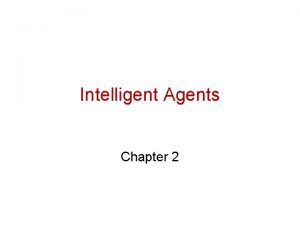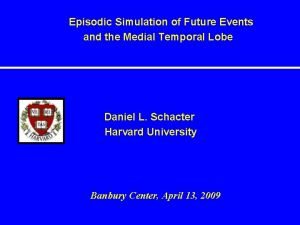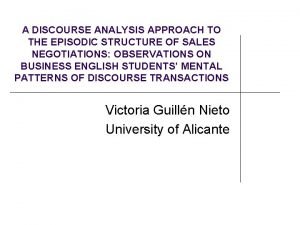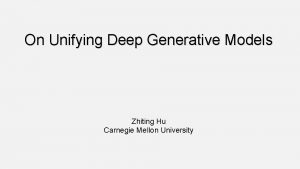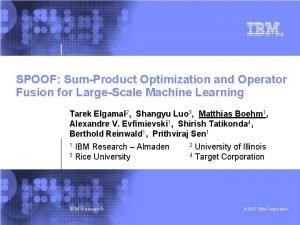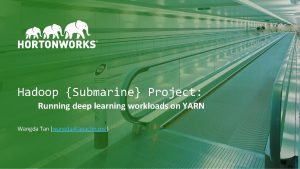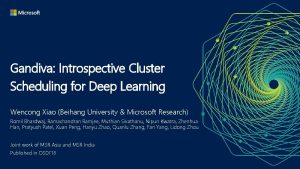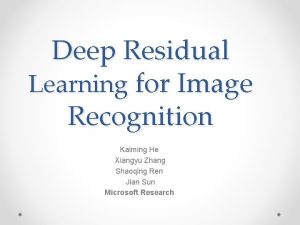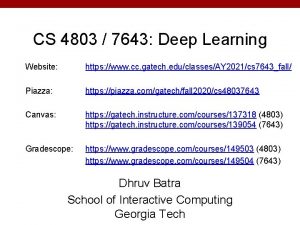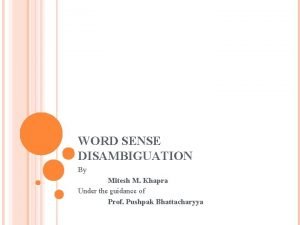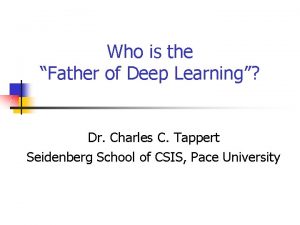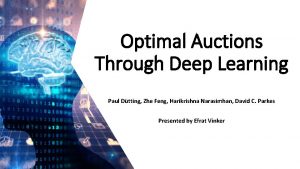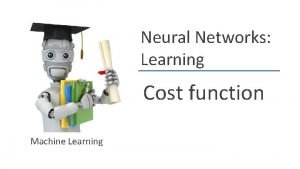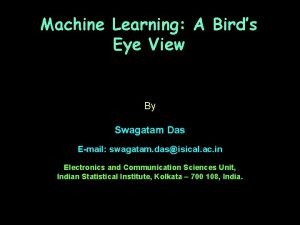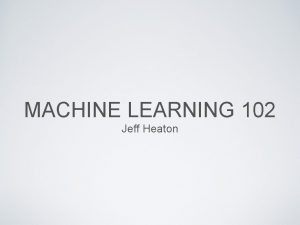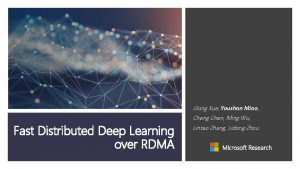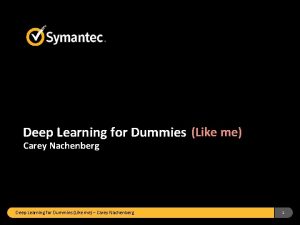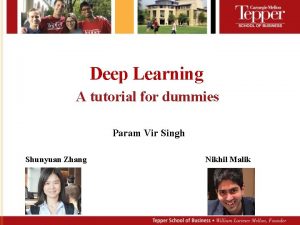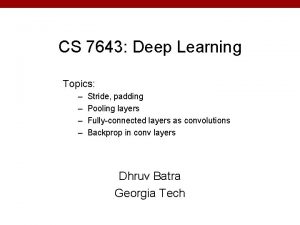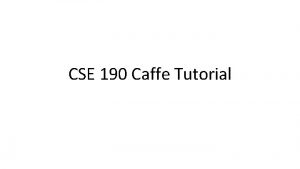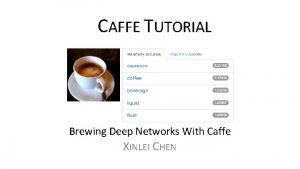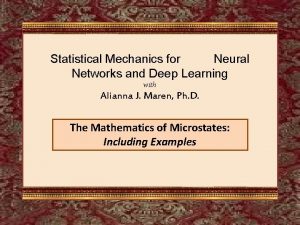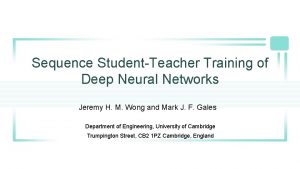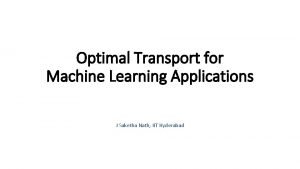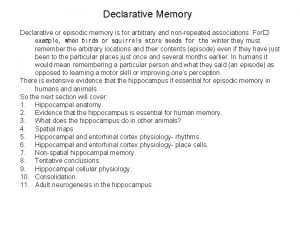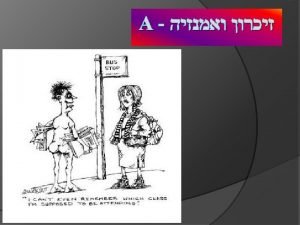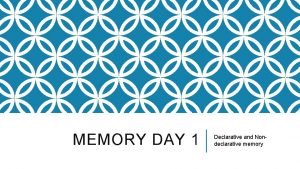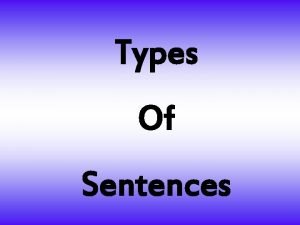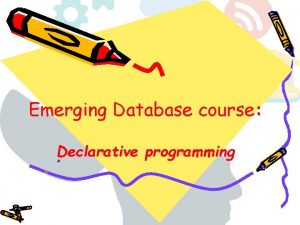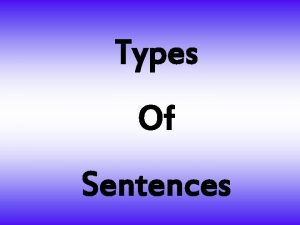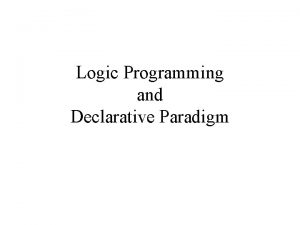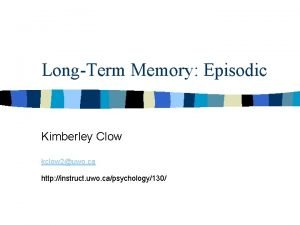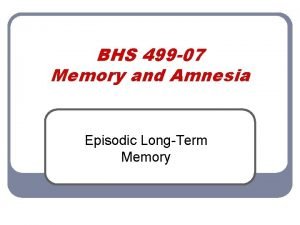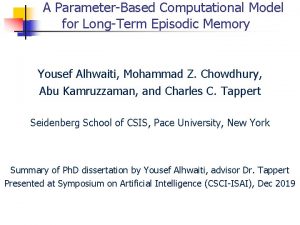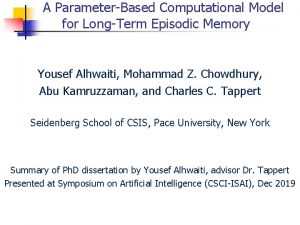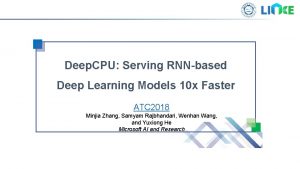OneShot Deep Learning Models of LongTerm Declarative Episodic




![Episodic memory is memory of the personally experienced and remembered events of life time[5]. Episodic memory is memory of the personally experienced and remembered events of life time[5].](https://slidetodoc.com/presentation_image_h2/0744931bea3f2921f785cc99341350b2/image-5.jpg)








































- Slides: 45

One-Shot Deep Learning Models of Long-Term Declarative Episodic Memory Yousef Alhwaiti Dissertation Advisor: Dr. Charles C. Tappert 1

Outline: ØIntroduction & Literature Review ØProblem statement ØMethodology ØDataset ØMethod#1 ØExperiment & Results ØMethod#2 ØExperiment & Results ØExperiments on probability of common a units ØExperiments demonstrating older memories fading away ØEstimating recall accuracy for human lifespan ØExperiments on the A_Z Handwritten Alphabet Dataset ØExperiments on the Fashion MNIST Dataset ØExperiments on the CFAR-10 Dataset ØAn improvement for the algorithm 2

Introduction and literature review Long-Term Declarative Episodic Memory ◦ Atkinson-Shiffrin model of memory Deep learning classification problems One-shot learning Weights versus features in the CNN 3

Long-Term Declarative Episodic Memory Atkinson-Shiffrin model of memory ◦ Sensory memory ◦ Capacity: unlimited ◦ Duration: less than one second ◦ Acting as a filter ◦ Short term memory ◦ Capacity: 5 -9 items ◦ Duration: less than one minutes ◦ Long term memory ◦ Capacity: unlimited ◦ Duration: lifetime ◦ Forgetting 4
![Episodic memory is memory of the personally experienced and remembered events of life time5 Episodic memory is memory of the personally experienced and remembered events of life time[5].](https://slidetodoc.com/presentation_image_h2/0744931bea3f2921f785cc99341350b2/image-5.jpg)
Episodic memory is memory of the personally experienced and remembered events of life time[5]. Include information about recent or past events and experience[6]. The recollection of experiences is contingent on three steps of memory processing[6]: ◦ encoding ◦ Storing ◦ retrieval 5

Deep learning classification problems ◦ Large number of examples for each category ◦ The network can not be tested on a new class. 6

One-shot learning-overview Human can learn from one or few examples One-shot learning aims to learn information about object categories from one, or only a few, training images. Why one-shot learning ◦ Few data for training/testing ◦ Human Memory records quickly like one-shot learning ◦ Flexibility in adding new categories 7

One-shot learning Cont. Calculating the distance between the input images and reference images. If the distance between the input image and the reference images is lower than a certain threshold, then the new image will be added to the database as a reference image. d(image 1; image 2) = the degree of the difference between images ◦ If d(image 1; image 2) >= γ ◦ If d(image 1; image 2) < γ same different 8

Weights versus features in the CNN Source : https: //towardsdatascience. com/converting-a-simple-deep-learning-model-from-pytorch-to-tensorflow-b 6 b 353351 f 5 d 9

Weights versus features in the CNN Source: https: //www. semanticscholar. org/paper/Steganalysis-via-a-Convolutional-Neural-Network-Couchot-Couturier/7 e 9708 d 9 dc 8 b 0 a 4 ac 2 fa 52 eb 384 d 67 f 52 d 7 cbbe 4 10

Problem statement This research is to identify mechanisms to replicate human long-term declarative episodic memory. 11

Methodology The Convolutional network will be used to create the recognition system. To create memory system, there are two methods: ◦ Method#1: Extracting hidden layer feature and store them in Num. Py array. ◦ Method#2: Using clock system 12

MNIST Dataset ◦ ◦ ◦ Set of handwritten digits 60, 000 samples for training and 10, 000 for testing. The samples are in gray-scale Fixed size 28 X 28 pixels We have used MNIST dataset to show the sequence to be remembered in the experiments. Source: https: //medium. com/syncedreview/mnist-reborn-restored-and-expanded-additional-50 k-training-samples-70 c 6 f 8 a 9 e 9 a 9 13

Method#1: Using Num. Py arrays to build the memory model 14

Method#1: Experiment Results ◦ Images sent through system over 4 days, recall accuracy is 100% for all images. ◦ Output results of recalling the sequence 8, 1, 5, 1, 2, 8, 4, 2, 7, 1, 1, 5 images Recalled sequence date time 15

Method#1: Experiment limitation ◦ Recall accuracy 100% for a sequence of any length ◦ Read and recall each of the following sequence ◦ 2 , 4, 6, 3 ◦ 4, 5 , 7 , 6 , 9 , 2 , 6 , 3 , 1 , 8 , 4 , 7 , 4 , 5 , 2 ◦ The shape of each stored feature is (1, 4, 4, 16) ◦ Long sequence = number of the sequence in life time ◦ 3. 15× 109 seconds in a generous 100 -year lifespan 16

Method#2: Use clock system to build memory model 17

Method#2: Adjusting the weights To adjust the weights between the hidden layer units and each clock unit we do the following: ◦ Creating the clock unit and determining the active units such as (1 , 0, 1) as shown in the figure ◦ Extracting hidden layer features ◦ Reshaping hidden layer output ex. (1, 4, 4, 16) (1, 256) 18

Method#2: Adjusting the weights (Cont. ) ◦ Creating the weight matrix ◦ Matrix shape w= Number clock units x Number hidden layer units, initialized ◦ Multiplying hj= clock x W ◦ If we have a reshaped hidden layer features h=( 0. 3, 0. 5, 0. 2, 0. 1) ◦ ( 1, 0, 1) = (0, 0, 0, 0) target ( 0. 3, 0. 5, 0. 2, 0. 1) ◦ Calculating the loss ◦ ( 0. 3, 0. 5, 0. 2, 0. 1) - (0, 0, 0, 0)= ( 0. 3, 0. 5, 0. 2, 0. 1) ◦ ( 0. 3, 0. 5, 0. 2, 0. 1)/2 =(0. 15, 0. 25, 0. 1, 0. 05) (2 active units) 19

Method#2: Adjusting the weights (Cont. ) ◦ Getting active units indexes. ◦ C= (1, 0, 1) active units indexes = [0, 2] ◦ Using active indexes numbers to update weighted ◦ Adding/ subtracting the loss 20

Method#2: Results: Memory Recall Accuracy Recall accuracy as a function of n = {4000, 8000, 16000, 32000, 64000} and a = {1, 2, 5, 10, 20, 50, 100}, using fixed s = 100. Accuracy versus #Active Units 21

Method#2: Simple Example to Explain Effect of Active Units Suppose parameters are s = 3, n = 3, and a = 1 1 0 0 0 1 Clock-system 22

Method#2: Simple Example to Explain Effect of Active Units Suppose parameters are s = 3, n = 3, and a = 2 1 1 0 0 1 1 1 0 1 Clock-system 23

Method#2: Experiment Results Recall accuracy as a function of n={4000, 8000, 16000, 32000, 64000} and s={100 , 200, 500, 1000, 2000, 5000, 10000}, using fixed a =2 24

Method#2: Experiments on probability of common a units § Common active units occur when two or more clock vectors in the sequence share the same active units. Suppose n=5, a=2 • C 1= [0, 0, 1] C 2= [1, 0, 0, 0, 1] Sample of the simulator results for the inputs s= 200 images , n= 100 , and a= 20 active units and 6 iteration §To calculate the probability of common units for c units in common is 25

Method#2: Experiments on probability of common a units § Also, we used the simulator to check the relation between common units and the sequence length. The inputs were s= {100, 500, 1000}, a=10, n=2000. 26

Method#2: Experiments on probability of common a units • We run the simulator with a =15 active units, s = 100 images, and various n = {500, 1000, 2000, 4000}, and using 15 iterations (random seeds) for each input to smooth the results. 27

Method#2: Experiments on probability of common a units § We used a sequence of s=100 images and tested them against a = {2, 8, 14, 20} active units using 15 iterations. 28

Method#2: Experiments demonstrating memories fading away § A key attribute of the novel memory training algorithm is that memory recall accuracy decreases as the memories (recalled images) recede farther back into the past. § In this experiment, we set n = 500 and a = 2, let s vary over the values {200, 400, 800, 1600}, and measured the recall accuracy within the 1 st tenth, 2 nd tenth, …, 10 th tenth of the recalled images 29

Method#2: Experiments demonstrating memories fading away 30

Method#2: Estimating recall accuracy for human lifespan §Recall accuracy depends on the relationship between the sequence length s and the total units n. §Assume humans have a memory event every second of their lives. §There are 3. 15× 107 seconds per year, or 3. 15× 109 seconds in a generous 100 -year lifespan §We can predict the accuracy for any sequence length using smaller sequences 31

Method#2: Estimating recall accuracy for human lifespan §Although calculating recall accuracy for large parameter values is computationally expensive, we can predict recall accuracy using small sequences as follows. n/s=64000/10000=6. 4 Pick a small sequence such as 100 Calculate n for small sequence n=100*6. 4=640 Now, we have the inputs s=100, a=2, n=640 Then, run these inputs on the simulator, the recall accuracy results was 92% 32

Method#2: Experiments on the A_Z Handwritten Alphabet Dataset § The A_Z Handwritten Alphabet dataset is a set of handwritten characters that contains 372451 § The images are in grayscales. § Image size 28*28 -pixel § It has 26 categories § Test inputs: n=200, a=2, and s = {100, 200, 400, 800} 33

Method#2: Experiments on the A_Z Handwritten Alphabet Dataset § Sample output for the inputs n=500, a=2, and s=100 34

Method#2: Experiments on the Fashion MNIST Dataset §The Fashion MNIST dataset has 70, 000 labeled fashion images §The images are in grayscales. §Image size 28*28 -pixel §It has 10 categories §Test inputs: n=200, a=2, and s = {100, 200, 400, 800} 35

Method#2: Experiments on the Fashion MNIST Dataset §Sample output for the inputs n=500, a=2, and s=100 36

Method#2: Experiments on the CFAR-10 Dataset § CFAR-10 dataset has 60, 000 images §The images are colored images RGB §The image size is 32*32 pixels §It has 10 categories. §Test inputs: n=200, a=2, and s = {100, 200, 400, 800} 37

Method#2: Experiments on the CFAR-10 Dataset § Sample output for the inputs n=500, a=2, and s=100 38

Method#2: An improvement for the algorithm § Current algorithm works by storing the clocks to use them when recall the sequence. §Every image has a clock. § 100 -year lifespan of 3153600000 seconds, need store 3153600000 clocks to recall the sequence. § Using seed() to generate the active units indexes. 39

Method#2: An improvement for the algorithm Suppose we have n=10, a=4 , and s=6. § For each image create a clock initialized with zeros § [0, 0, 0, 0] § Use seeds with current counter to generate active units indexes. [ 6, 9, 0, 2] § Activate the indexes [ 6, 9, 0, 2] in the clock. [1, 0, 0, 0, 1, 0, 0, 1] § Use the algorithm to adjust the weights § In the same way generate the clock when recall. 40

Method#2: An improvement for the algorithm § Producing a clock for each input. § Sample output of the simulator using seeds for the inputs n= 200, a=2, and s=100 41

Conclusions § In conclusion, the major contributions of this research are: § Design and analysis of a parameter-based computational model of longterm declarative episodic memory. § Creation of a unique one-shot training algorithm for the clock memory of the system that not only provides adequate memory recall over a human lifetime but also demonstrates decreased memory recall for events as they recede into the past. § Discovery of a method of estimating the memory recall accuracy for various parameter settings over a human lifespan. § Experiments conducted on a variety of popular image databases to show that the model is not database dependent. 42

Publications ◦ Yousef Alhwaiti, M. Z. Chowdhury, A. Kamruzzaman, and C. C. Tappert, ”Analysis of a Parameter-Based Computational Model of Long-Term Declarative Episodic Memory. ”Proc. 6 th Annual Conf. Comp. Science Comp. Intelligence: Artificial Intelligence (CSCI-ISAI), Las Vegas, Dec 2019 ◦ Abu Kamruzzaman, Yousef Alhwaiti, and Charles C. Tappert "A Comparative Study of Convolutional Neural Network Models with Rosenblatt’s Brain Model, "Proc. IEEE Future of Information and Communication Conf. (FICC) , San Francisco, Mar 2019 ◦ A. Kamruzzaman, Yousef Alhwaiti, A. Leider, and C. C. Tappert, "Quantum Deep Learning Neural Network, " Proc. IEEE Future of Information and Communication Conf. (FICC) , San Francisco, Mar 2019 ◦ Sukun Li, Abu Kamruzzaman, Yousef Alhwaiti, Peiyi Shen, and Charles C. Tappert "Emotion Recognition using Unsupervised and Supervised Learning and Simulate Emotions with Brain Model" Pace CSIS Research, 2018 ◦ Yousef Alhwaiti, Mohammad Chowdhury, Abu Kamruzzaman, Charles C. Tappert “One-Shot Deep Learning Models of Long-Term Declarative Episodic Memory” Pace CSIS Research, 2019 43

1. References Couchot, J. , Couturier, R. , Guyeux, C. , & Salomon, M. (2016). Steganalysis via a Convolutional Neural Network using Large Convolution Filters. Ar. Xiv, abs/1605. 07946. 2. Lee, Y. X. (2019, May 23). Converting a Simple Deep Learning Model from Py. Torch to Tensor. Flow. Retrieved from https: //towardsdatascience. com/converting-a-simple-deep-learning-model-from-pytorch-to-tensorflowb 6 b 353351 f 5 d. 3. One-shot Learning. (2018) Retrived from http: //ice. dlut. edu. cn/ valse 2018/ppt/07. one_shot_add_v 2. pdf 4. Mc. Leod, Saul. “Saul Mc. Leod. ” Atkinson and Shiffrin | Multi Store Model of Memory | Simply Psychology, 1 Jan. 1970, www. simplypsychology. org/multi-store. html. https: //www. sciencedirect. com /topics/agricult-ural-andbiological-sciences/declarative-memory 5. Betournay, Scott. “Long Term Memory. ” Slide. Player, 2016, slideplayer. com /slide/ 5224563/. 6. Mastin, Luke. “ EPISODIC & SEMANTIC MEMORY. ” Episodic Memory and Semantic Memory - Types of Memory The Human Memory, 2018, www. human-memory. net/types_episodic. html. 7. “Memory. ” Memory and Aging Center, University of California San Francisco, memory. ucsf. edu/memory. 8. Rosebrock, A. Fashion MNIST with Keras and Deep Learning. https: //www. pyimagesearch. com/2019/02/ 11 / fashion-mnist-with-keras-and-deeplearning/. 9. Krizhevsky, A. The CIFAR-10 dataset, 2009. Available at https: //www. cs. toronto. edu/ kriz/cifar. html. 10. Lee, Yu Xuan. “Converting a Simple Deep Learning Model from Py. Torch to Tensor. Flow. ” Medium, Towards Data Science, 23 May 2019, https: //towardsdatascience. com/converting-a-simple-deep-learning-model-frompytorch-to-tensorflow-b 6 b 353351 f 5 d. 44

Thank you 45
 Kubernetes vgpu
Kubernetes vgpu Lts stable
Lts stable Thomas silverstein art
Thomas silverstein art Cmu machine learning
Cmu machine learning Deep learning approach and surface learning approach
Deep learning approach and surface learning approach Episodic vs semantic memory
Episodic vs semantic memory In a climactic drama the plot begins early in the story
In a climactic drama the plot begins early in the story Peas description for medical diagnosis system
Peas description for medical diagnosis system Framing strategy examples
Framing strategy examples Constructive episodic simulation hypothesis
Constructive episodic simulation hypothesis Episodic structure definition
Episodic structure definition Deep asleep deep asleep it lies
Deep asleep deep asleep it lies Deep forest: towards an alternative to deep neural networks
Deep forest: towards an alternative to deep neural networks O the deep deep love of jesus
O the deep deep love of jesus Dilan gorur
Dilan gorur Zhiting hu
Zhiting hu What are modals and semi modals
What are modals and semi modals Cuadro comparativo de e-learning
Cuadro comparativo de e-learning Operator fusion deep learning
Operator fusion deep learning Andrew ng recurrent neural networks
Andrew ng recurrent neural networks Hortonworks gpu
Hortonworks gpu Gandiva: introspective cluster scheduling for deep learning
Gandiva: introspective cluster scheduling for deep learning Deep residual learning for image recognition
Deep residual learning for image recognition Deep learning speech recognition
Deep learning speech recognition Cs 4803
Cs 4803 Autoencoders
Autoencoders Supervised vs unsupervised learning
Supervised vs unsupervised learning Mitesh khapra
Mitesh khapra Who is the father of deep learning?
Who is the father of deep learning? Optimal auctions through deep learning
Optimal auctions through deep learning New pedagogies for deep learning
New pedagogies for deep learning Cost function deep learning
Cost function deep learning Bird eye view deep learning
Bird eye view deep learning Jeff heaton github
Jeff heaton github Fast distributed deep learning over rdma
Fast distributed deep learning over rdma Carey nachenberg slides
Carey nachenberg slides Backpropagation for dummies
Backpropagation for dummies Cs 7643 deep learning github
Cs 7643 deep learning github Moe deep learning
Moe deep learning Analogizers
Analogizers Intel deep learning training tool
Intel deep learning training tool Caffe deep learning tutorial
Caffe deep learning tutorial Caffe python tutorial
Caffe python tutorial Statistical mechanics of deep learning
Statistical mechanics of deep learning Student teacher neural network
Student teacher neural network Ioslides
Ioslides







